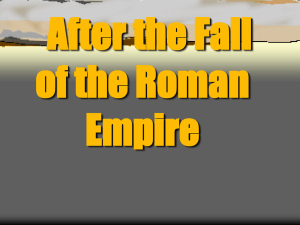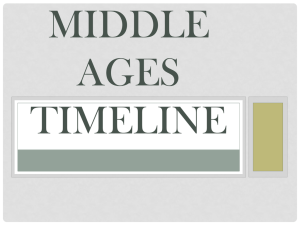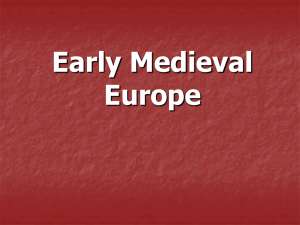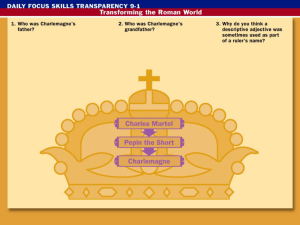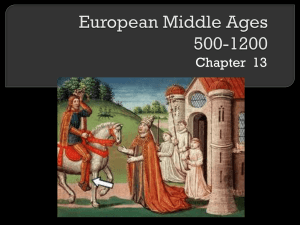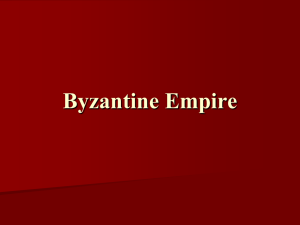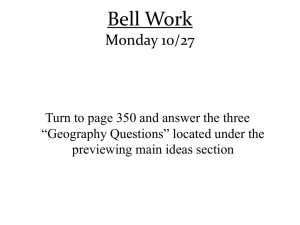Chapter 13 European Middle Ages 500 * 1200 A.D.
advertisement
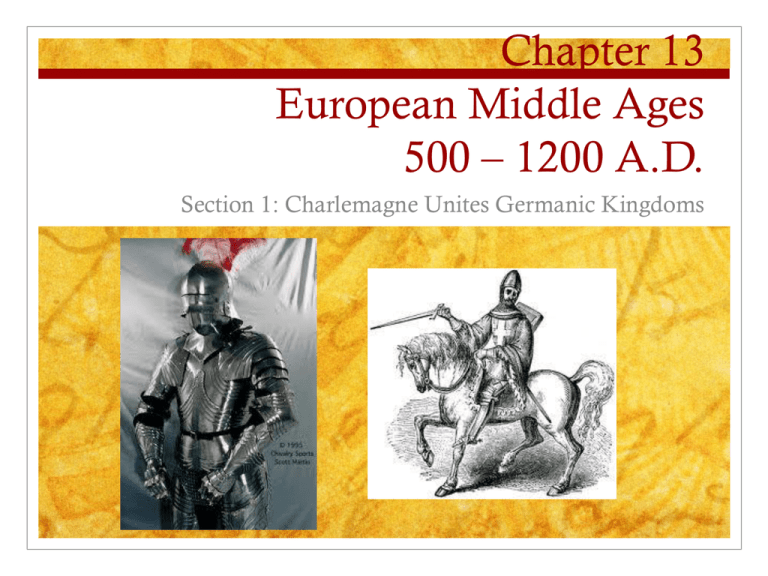
Chapter 13 European Middle Ages 500 – 1200 A.D. Section 1: Charlemagne Unites Germanic Kingdoms 13.1 Vocabulary • Middle Ages • Franks - Era in European history following the fall of the Roman Empire, lasting from about 500 to 1500—also called the medieval period. People who settled in the Roman province of Gaul (roughly the area now occupied by France) and established a great empire during the Middle Ages. Religious community of men (called monks) who have given up their possessions to devote themselves to a life of prayer and • monastery • secular - worship. concerned with worldly rather than spiritual matters. • Carolingian Dynasty • Charlemagne- a dynasty of Frankish rulers, lasting from A.D. 751 to 987 Charles the Great, Emperor of the Frankish kingdom from 771 to 814 Fall of Roman Empire Roman Empire divides into East and West in year 395 East becomes Byzantium Justinian becomes Emperor in 527 Byzantine Empire collapses around 1100 A.D. Middle Ages 500 – 1500 A.D. Three Roots of Medieval Culture Classical heritage of Rome Beliefs of Roman Catholic Church Customs of Germanic Tribes What are the effects of multiple invasions? Invasions of Western Europe Effects of Invasions: Disruption of Trade Downfall of Cities Population changes Decline of Learning Loss of Common Language Germanic Kingdoms Emerge The Roman catholic church survives invasions The concept of government changes Family more important Smaller communities Unwritten rules Personal relationships important Warriors lived with Kings It was a disgrace to outlive him Clovis Rules the Franks Clovis brought Christianity in year 496 Battle convinced him to convert Asked for God’s help United Franks into one kingdom Germans Adopt Christianity Church and Franks worked together to spread Christianity Many moved back into Rome Church built religious communities : Monasteries Monks and Nuns lived there Monasteries An Empire Evolves After death of Clovis in 511, Charles Martel takes control (Charles the Hammer) He was not Emperor Gained more power than the King Extended the kingdom Defeated Muslims Became Christian Hero An Empire Evolves Charles Martel passed power to son Pepin the Short Gained title “King by Grace of God” Began Carolingian Dynasty in 751 A.D. Charlemagne Becomes Emperor Pepin died in 768 Frankish kingdom VERY strong Charlemagne took over after Pepin’s son Carloman mysteriously died 771 Charlemagne Becomes Emperor Charlemagne extends empire After helping the pope in Rome, he was crowned Roman Emperor He was not from Rome! Charlemagne Leads Revival Charlemagne managed his Empire very well Encouraged learning Opened schools Encouraged monasteries to open schools for future monks Charlemagne dies in 814 Names only son Louis the Pious (The Fair) as Emperor Not very good Louis the Pious’ sons fought for power Divided empire into 3 parts Authority broke down Quiz Next Class 13.1 Vocabulary • Middle Ages • Franks - Era in European history following the fall of the Roman Empire, lasting from about 500 to 1500—also called the medieval period. People who settled in the Roman province of Gaul (roughly the area now occupied by France) and established a great empire during the Middle Ages. Religious community of men (called monks) who have given up their possessions to devote themselves to a life of prayer and • monastery • secular - worship. concerned with worldly rather than spiritual matters. • Carolingian Dynasty • Charlemagne- a dynasty of Frankish rulers, lasting from A.D. 751 to 987 Charles the Great, Emperor of the Frankish kingdom from 771 to 814 Chapter 13 European Middle Ages 500 – 1200 A.D. Section 2: Feudalism in Europe 13.2 Vocabulary in feudal Europe, a person who controlled land and could therefore grant estates to vassals. fief- an estate granted to a vassal by a lord under the feudal system in medieval Europe. vassal- in feudal Europe, a person who received a grant of land from a lord in exchange for a pledge of loyalty and services. lord- knight- in medieval Europe, an armored warrior who fought on serf- manor- a lord’s estate in feudal Europe. tithe- a family’s payment of one-tenth of its income to a church. horseback. a medieval peasant legally bound to live on a lord’s estate. Invaders Attack Western Europe Many invaders came from year 800-1000 Vikings invade from the North Also called Northmen or Norsemen Worshipped war like gods Nicknames like Eric Bloodaxe and Thorfinn Skullsplitter Invaders Attack Western Europe Vikings used swords and heavy wooden shields Arrived on huge ships, attack and leave Ships were huge Could travel in 3 feet of water Vikings stopped attacking after they accepted Christianity warmer weather made farming easier Viking Leif Ericson reached North America around year 500 Invaders Attack Western Europe Magyars were a nomadic people attacked from East Rode horses Did not settle Took captives to sell as slaves Muslims attacked from South Conquered different areas Invaders Attack Western Europe Effects of invasions A lot of disorder and suffering Lived in constant fear and danger Kings could not effectively defend Local rulers gained strength for defeating invaders New Social Order: Feudalism =Vassal = Serf Feudalism: A political and economic system of Europe based on the holding of all land in fief or fee … and characterized by homage, legal and military service of tenants, and penalty In exchange for military protection a lord (land owner) granted land called fief. The Person receiving fief was a vassal New Social Order: Feudalism =Vassal = Serf Social classes were well defined You were born into your social class Serfs were not slaves Could not leave the land Could not be bought or sold Everything they produced belonged to lord Manors: The Economic Side of Feudalism Manor = Lord’s Estate Manor System: Lord provided serfs with housing, farm land, and protection Serfs tended to land, cared for lords animals, and maintained the estate All peasants owed the lord duties Certain days of labor or amount of grain Manors: The Economic Side of Feudalism Manors were only a few square miles 20-30 families lived there Self sufficient community Manor life was hard Peasants paid many taxes Including tithe – church tax 10% of income A lot of working Life expectancy = 35 years old Chapter 13 European Middle Ages 500 – 1200 A.D. Section 3: The Age of Chivalry 13.2 Vocabulary • chivalry 1 • tournament 2 • troubadour 3 Knights: Warriors on Horseback Charles Martel organized armored horsemen called Knights Technology: Saddle and stirrups Allowed soldiers to fight on horses Warrior’s trained all year Were given land Knighthood and Code of Chivalry Chivalry – Complex code of ideals A knight must fight bravely for 3 masters Feudal lord Heavenly lord His lady Knights must be loyal, brave and courteous A Knight’s Training Boys learned the code of chivalry early in life Age 7, sent off to another castle to learn fighting skills Age 14, became a squire, or servant to a knight Age 21, a squire became a knight A young knight traveled for 2 years in search of wars and tournaments Do not Copy Medieval Europe Feudalism Design of Castle Brutal Reality of Warfare War was brutal Hot oil, water or lead was poured on soldiers Archers shot arrows to defend castle Literature of Chivalry Many stories glorified castle life Epic poetry – poems that retold stories, adventures They wrote love poems and songs Troubadours were traveling musicians Women’s Role in Feudal Society Noblewoman – Could own little land Could send knights to war Threw rocks and fire arrows at attackers Peasant Woman – A lot of labor in home and fields Child care Young women learned house duties Chapter 13 European Middle Ages 500 – 1200 A.D. Section 4: The Power of Church 13.4 Vocabulary • clergy • sacrament • canon law • Holy Roman Empire • lay investiture The Far Reaching Authority of the Church Church and European rulers competed for power Church had its own organization Pope Clergy Bishop Priests Feudalism divided many people Religion unified them Being part of religious community Law of the Church Canon Law Marriage Religious practices Consequences Excommunication Interdict - religious services would not be performed The Church and the Holy Roman Empire Otto the Great was king of Germany in 936 Built up his power by forming alliance with church Limited the power of nobles Later invaded Italy on Pope’s behalf and was named emperor German-Italian Empire became Holy Roman Empire Caused many problems The Emperor Clashes with the Pope Church not happy that the Emperor controlled the clergy Lay investiture – kings and nobles appoint clergy 1075, Pope banned lay invesiture German Emperor Henry IV was upset Tried to force the pope to resign Emperor was excommunicated Begged Pope for forgiveness to save throne Showdown at Canossa King Henry went to meet the Pope The Pope forced Henry to wait outside for 3 days in the snow The Pope was forced to forgive Successors to Pope and Emperor met Established Concordat of Worms Treaty: Church could appoint Bishops Emperor could veto Disorder in the Empire King Fredrick is elected in 1152 Barabarossa Aggressively invaded rich cities in Italy Pope and Italian merchants formed alliance called Lombard League Lombard league soldiers defeated King Fredrick Used crossbows against knights Fredrick was forced to make peace Chapter Test Monday! Study Chapter 13


